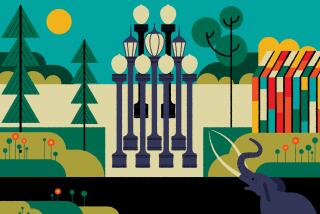The Treasures of a Bone Yard
- Share via
The 23 acres of Hancock Park’s La Brea Pits were presented to the citizens of Los Angeles in 1916 by Captain George Allan Hancock, with the stipulation that its scientific features be preserved.
It was within this area of the original 4,000-plus acres of Rancho La Brea that one of the world’s most extraordinary collections of Pleistocene fossils was discovered in 1875.
The first historic reference to the tar pools was recorded in 1769 in the diary of Gaspar de Portola, governor of Lower California, after his expedition had crossed the Los Angeles River and headed west along the route we now call Wilshire Boulevard.
He noted that the tar was used by the Indians to line their baskets and caulk their canoes. Later the tar from the “La Brea springs” would be used to cover the roofs of the first adobe houses to be built in Los Angeles, and in 1835, the inhabitants of the Pueblo would be given the right to take freely of the “asphaltum” to waterproof their homes. Except that on very hot days, it is said the people carefully avoided walking under the eaves.
One favorite nickname for La Brea Tar Pits was La Huesementa --the bone yard. Early diggers had frequently found bones that they discarded as worthless, and avoided certain areas where the bone deposit was so thick that it became impractical to extract the asphaltum.
It is suspected that the giant mammals of the Ice Age were drawn to the shiny surfaces on the ground and, when tempted to drink from them, were tangled and trapped in the tar; their desperate cries would attract predators who, in turn, would sink in the viscous battleground, along with their victims.
The richest bone deposits represent vertical accumulation in conical chimneys; geologists and archaeologists have advanced the theory that the traps may have been caused by seismic changes. Even today, there is constant agitation in the bubbling ponds of tar.
How fortunate for the hidden treasures of the bone yard that those traps remained relatively undisturbed!
The heritage of more than one million prehistoric specimens since recovered from the asphalt deposits, are showcased in the aesthetic, on-site George C. Page Museum that is a branch of the Los Angeles County Museum of Natural History; the area itself is a designated historic landmark.
What a wonderful solution to a sticky situation.
More to Read
Sign up for Essential California
The most important California stories and recommendations in your inbox every morning.
You may occasionally receive promotional content from the Los Angeles Times.













